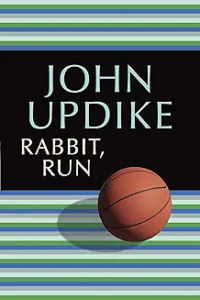Rabbit, Run by John Updike 1960
John Updike (March 18, 1932-January 27, 2009) was one of my favorite authors as I discovered literature in college. A fellow alumnus of Harvard (though he is the one who graduated summa and Phi Beta Kappa), he’s one of only four authors to win multiple Pulitzer Prizes, and his prolific output of novels, short stories, poetry, essays, and literary and art criticism fill a long shelf in my Vermont library.
Updike’s landscape was the small town of Tarbox, often thought to be modelled on Ipswich, MA, where regular people struggled with marital fidelity, religion, careers, money, friends and family. In hundreds of short stories, reviews, and criticism in ‘The New Yorker’ and ‘The New York Review of Books’, he delved deeply into the challenges of life for his characters from Harry Angstrom to Henry Bech, from a Protestant high school basketball star to a Jewish Nobel Laureate. Along the way he wrote about an African dictator, New England witches, and proving the existence of God among other topics. Multiple National Book, PEN/Faulkner, and Pulitzer awards recognized his role as one of America’s leading writers.
I chose to re-read “Rabbit, Run” because it was one of his earliest novels and because it was the first in the four book series that included “Rabbit Redux” 1971, “Rabbit Is Rich” 1981, and “Rabbit At Rest” 1990 which earned Updike his greatest honors. It’s the story of Harold, aka Harry aka Rabbit Angstrom, a former high school basketball super star in his small New England town of Mt. Judge who at 26 is married, has one child and another on the way, and is sinking into the abyss of anomie. He runs out on his alcoholic, depressive wife, lives with a prostitute in the neighboring town, and returns for the birth of his daughter with tragic consequences. I found the tension in the book to be almost unbearable especially the chapter in which Updike shifts the narration from Harry to his wife, Janice to convey the heart-breaking outcome of Rabbit’s inability to take responsibility. Rabbit is a vivid and powerful character whose life Updike continued to chronicle for 30 years.
Updike’s criticism collected in nine volumes and his memoir “Self-Consciousness” are also well worth reading. His comments on book reviewing contained in his 2008 Jefferson Lecture provide valuable guidance for my own writing:
- “Try to understand what the author wished to do, and do not blame him for not achieving what he did not attempt.
- Give enough direct quotation—at least one extended passage—of the book’s prose so the review’s reader can form his own impression, can get his own taste.
- Confirm your description of the book with quotation from the book, if only phrase-long, rather than proceeding by fuzzy précis.
- Go easy on plot summary, and do not give away the ending.
- If the book is judged deficient, cite a successful example along the same lines, from the author’s œuvre or elsewhere. Try to understand the failure. Sure it’s his and not yours?
To these concrete five might be added a vaguer sixth, having to do with maintaining a chemical purity in the reaction between product and appraiser.”
Updike is one of our great American authors of the 20th C. Praised by Philip Roth (“John Updike is our time’s greatest man of letters, as brilliant a literary critic and essayist as he was a novelist and short story writer. He is and always will be no less a national treasure than his 19th-century precursor, Nathaniel Hawthorne.”) among many others, I hope to re-read more of his work as the years go by.



